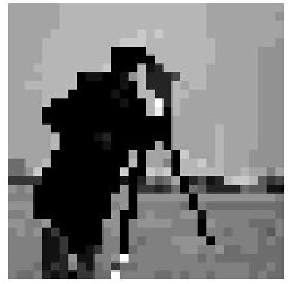Biomedical Engineering Reference
In-Depth Information
Figure 4. The cameraman image
b.
A more practical example is given below.
In this case, it has been studied how, by
overflowing the network capacity, the net is
able to extract relationships between patterns
and form clusters or groups representing
concepts.
Here, the problem is to cluster an image, attend-
ing to its contents. It's a rather simple example, but
it has many applications in image segmentation
and understanding. For more details on image
processing techniques, see Egmont-Petersen et
al. (2002) and references therein.
In our case, the well-known cameraman image
(Figure 4) has been used as benchmark.
This image (256x256 pixels) was divided in
windows of size 8x8 pixels. Each window repre-
sents a pattern, rearranging its values columnwise
from top to bottom. So, there were 1024 patterns
of dimension 64.
These patterns were loaded into a MREM
network with 64 neurons. Then, the net was
initialized with every pattern, and the corre-
sponding stable state (a new window) was used
to substitute the original window. The resulting
clustering can be viewed in Figure 5. It should
be noted that there were 14 different clusters,
detected automatically.
The stable states achieved by the net cor-
respond to concepts. Since pattern components
were gray values of pixels, the network has learnt
concepts related to these graylevels.
The interesting point is that all this work
has been done in an unsupervised way. Other
clustering methods need to adjust the number
of clusters before the training, and are based on
Euclidean distance, which implies that patterns
are embedded in the Euclidean space. However,
discrete patterns like the ones described in this
work can be non-numerical (qualitative) and may
have a different topology from the usual one in
the Euclidean space.
Figure 5. The resulting image after performing
the unsupervised clustering
low classification error (from 0% to 4.80% on aver-
age), but in addition these new techniques get the
exact, or very approximate, number of groups in
which the pattern set is actually divided in almost
every simulation. In fact, whenever the number
n
of discovered clusters equals
n
, an error percentage
of 0% is obtained, retrieving in those cases the
initial centroids. It can also be verified that IRL
clearly outperforms RL in most cases, getting a
more accurate classification and improving the
estimation of the number of clusters, as seen in
the last row of the table.


Search WWH ::

Custom Search